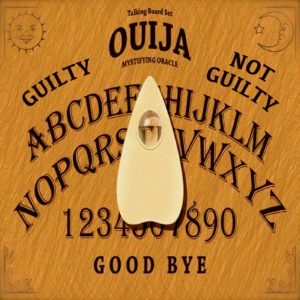By Dr. Ken Broda Bahm:

Add this one to the list of reasons why sequestering the jury can be a problem, and more generally, to the “Juries can do strange things” category. The night before deliberations, at the end of a five-week murder trial, four jurors gathered in a hotel room as the others slept. Using a crude Ouija board made from a piece of paper and a wine glass, they established contact with one of the two murder victims. “Who killed you?” one of the jurors asked. The glass spelled out the answer, “Stephen Young done it.” Asking how it happened, jurors saw the answer: “Shot.” Then, the spirit got even more specific, using the board to spell out, “Vote guilty tomorrow.” Which is, of course, what the jurors did.
That scenario, which played out in Australia back in 1994, is not typical, of course. But there have been many other similarly cringe-inducing efforts of jurors to divine their way to a verdict, including early discussions, unauthorized field trips to the scene of the crime or the tort, consulting the “Holy Spirit,” or otherwise using group prayer during deliberations, and of course, too many instances of Google-aided deliberations to count. More appropriately, jurors can also be counted on to test the evidence on their own and to reenact the incident if they can. Of course, one reading of these extracurricular efforts is that jurors are either bored or distressed over the case. But more broadly, these efforts underscore the motivation to find an independent basis for the decision — something separate from the attorneys and the presentation of the evidence in court. That separate ground can be enticing when jurors don’t truly trust either side, and don’t fully understand or appreciate the rules of evidence or the facts and advocacy provided.They want to find their own way to a decision. While Ouija-driven verdicts are the exception, the search for a way that is at some level independent tends to be the rule. There are a few ways we can expect them to do this.
They’ll Search for their Own Way…
On Instructions
So your instructions on the law, finalized at the end of trial, are weighing in at 35 pages — a dense 35 pages. But that is okay, you think, because you know which of those instructions are the important ones, and you will highlight and explain those in simple terms during closing. However, once jurors find themselves on their own in the deliberation room, they set aside that guidance and start at the beginning of the instructions, going laboriously through every one, applying their own understandings to even those you didn’t emphasize. That can lead to perverse results, and before you know it, you can have a jury believing that negligence requires intent, or that cause can be apportioned to only one party, or that damages can be awarded independent of whether they are caused by the defendant’s negligence or not — all of which I have seen during mock jury deliberations.
On Evidence
You put a document up on the screen during trial. Using your trial presentation software, you immediately do a call-out in order to expand and emphasize the most relevant lines in the document. But watch the jurors’ eyes: After a quick look at the portion you are calling out, their eyes move to scan the rest of the text on the screen to see what you left out. At mock trials, we give the jurors binders full of exhibits, and there are always a few who will spend their precious breaktime reviewing the documents in full. “Where is the trust?” you might think, “If it was important, I’d have called it out.” Jurors might want to believe you, but bottom line, they don’t. They know that you are an adversary working for one side and trying to spin them toward the verdict you prefer.
On Your Case Story
You have put together a narrative of what happened. The entire presentation, from the start of voir dire to the last moments of closing argument has been dedicated to building and reinforcing that narrative. It explains everything in the best possible light, and it should answer all of their questions. Still, like a detective, they will take your story with a grain or two of salt while they sniff out what you aren’t emphasizing. Ultimately, they might believe that “the real story” lies somewhere between the two they’re hearing in the courtroom.
Ultimately, as long as you are dealing with active and motivated listeners, you cannot simply make them passive. They know this is important, and they know they have two sides trying to persuade them. Not really trusting either guide, they want to be their own guide. So, it isn’t a matter of finding ways to just get them to listen to you and do what you say. Instead, the implication is to realistically account for that independent streak, and also to adapt and influence their search even when you cannot determine it.
So give jurors guidance on instructions, and highlight the ones that you think will matter the most. But also expect they will review it all, so supply common-sense definitions, and anticipate likely misunderstandings. Also use the screen to highlight the parts of the documentary evidence that matter the most. But account for the fact that jurors will want to know the rest of it, so summarize what you aren’t showing them as well, and reassure them that they can look at it all in detail during their deliberations. And finally, tell your own case story, but expect a skeptical audience that is motivated to compromise rather than to fully accept one story or the other.
Other Posts on Jurors’ Process:
- Determine Whether Your Jurors Are Driven by Process or by Verdict
- Expect Jurors to Climb Into the Cooler
- See Persuasion as a Process (Toward a Unified Theory of Legal Persuasion)